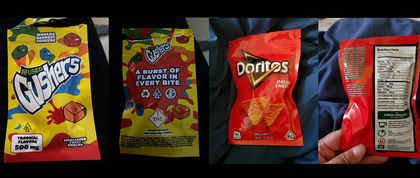
Cannabis edibles – foods infused with cannabis – are a popular and growing segment of the cannabis market. Edibles can be homemade or commercially produced and can be purchased online, or through dispensaries and independent sellers. A study in 2018 estimated that 40 percent of cannabis users had an edible in the past year, and a 2020 survey found that 13.4 percent of past-year cannabis users primarily used cannabis by eating it.
As cannabis markets become increasingly diversified, my colleagues Emily Goldmann and Melody Goodman joined me to investigate what people use now. As a part of a pilot study funded by the Center for Drug Use and HIV|HCV Research to describe the use of new cannabis products, we asked respondents to an internet survey of cannabis users to upload photos of up to two of their cannabis products.
Of the total 731 photos of cannabis products we collected, 267 (36 percent) were edibles, of which 22 (8 percent) represented 13 unique copycat or look-alike edibles that use the same or similar brand name, logo, and/or imagery as an existing commercial non-cannabis counterpart (CNCC). They are typically candies, cookies, brownies, or other snack foods. Since 2019, articles by Reuters, the New York Times and the Washington Post have reported on these products in the context of trademark violations and safety concerns.
Our team, which also included GPH alumnus Kyle Snyder, GPH doctoral students Simon Sandh and Daniel Hagen, Morgan State University MPH alumna Kewanda Collier, and University of Pennsylvania faculty Andy Tan, conducted a content analysis of the copycat/look-alike packaging. We assessed each package for similarities with its CNCC with respect to brand name, product name, font, color, flavors, and brand/promotional characters. We also examined cannabis content indicators, including THC content per package and serving, cannabis leaf symbol, product warnings, cannabis terms, cannabis motifs, activation time, and guidance on edible use.
Our content analysis revealed that (1) copycat/look-alike edibles subtly indicated cannabis content while using high-fidelity replication or imitation of their CNCC; (2) THC content was high (an average of 459 mg of THC per package) in the equivalent of a single serving of a CNCC; and (3) these products may be attractive to children.
These copycat and look-alike edibles reveal safety issues in the cannabis market in terms of the possibility of accidental dosing, as well as ingesting more THC than intended. If you decide to buy copycat/look-alike cannabis edibles, be sure to store them separately from their non-cannabis counterparts, keep them out of reach of children, and pay attention to the THC content so you can dose yourself to achieve your desired effect.

Danielle Ompad, PhD
Associate Dean for Education;
Associate Professor of Epidemiology